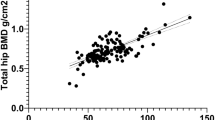Abstract.
The object of this study was to determine the effectiveness of calcaneal ultrasonometry in the prediction of bone mineral changes in the lumbar spine and femoral neck in response to treatment of osteoporosis. There were 673 women in the study who had one or more follow-up measurements between 1 and 4 years after the initial baseline determination for a total of 881 same-day measurements of the calcaneus, spine, and femur. The LUNAR Achilles and LUNAR DPX (LUNAR Corporation, Madison, WI) were used. Patients were divided into three treatment time groups: Group 1, 1–<2 years, n = 461; Group 2, 2–<3 years, n = 278; Group 3, 3–<4 years, n = 142. There were significant increases in the bone mineral density (BMD) of the lumbar spine, femoral neck, and in the broadband ultrasonic attenuation (BUA) of the calcaneus for the three groups. In contrast, a significant decrease in speed of sound (SOS) was obtained in these time frames and the stiffness index remained unchanged. Spearmen correlations showed an inverse relationship between the percent changes in SOS and BUA, the reasons for which are speculative. Correlations between the percent changes in calcaneal parameters and the BMDs of the lumbar spine and femoral neck were weak, whether significant or not, rho varying from −0.12 to 0.20. There was a subset of 371 patient measurements that registered BMD increases in both the lumbar spine and femoral neck. This was considered to be an objective indication of adequate compliance with prescribed treatment. Analysis of this subset yielded parameter correlations similar to those of the entire group. It is concluded that changes in the calcaneal ultrasound parameters in response to treatment of osteoporosis are not a reflection of mineral changes occurring in the lumbar spine and femoral neck in a given individual, and in this regard, calcaneal ultrasonometry is not a substitute for direct-site dual X-ray absorptiometry (DXA) measurement of the lumbar spine and femur.
Similar content being viewed by others
Author information
Authors and Affiliations
Additional information
Received: 19 February 1998 / Accepted: 24 June 1998
Rights and permissions
About this article
Cite this article
Rosenthall, L., Caminis, J. & Tenehouse, A. Calcaneal Ultrasonometry: Response to Treatment in Comparison with Dual X-ray Absorptiometry Measurements of the Lumbar Spine and Femur. Calcif Tissue Int 64, 200–204 (1999). https://doi.org/10.1007/s002239900602
Issue Date:
DOI: https://doi.org/10.1007/s002239900602




